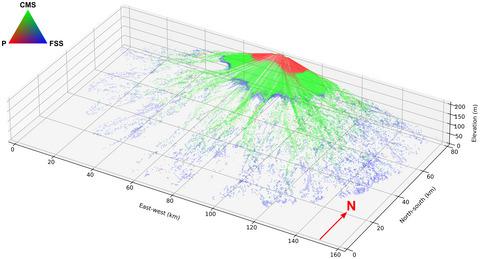当前位置:
X-MOL 学术
›
Basin Res.
›
论文详情
Our official English website, www.x-mol.net, welcomes your feedback! (Note: you will need to create a separate account there.)
Stratigraphic forward modelling of distributive fluvial systems based on the Huesca System, Ebro Basin, northern Spain
Basin Research ( IF 3.2 ) Pub Date : 2021-08-18 , DOI: 10.1111/bre.12597 Swiad Snieder 1 , Cedric M. Griffiths 2 , Amanda Owen 1 , Adrian J. Hartley 1 , John A. Howell 1
Basin Research ( IF 3.2 ) Pub Date : 2021-08-18 , DOI: 10.1111/bre.12597 Swiad Snieder 1 , Cedric M. Griffiths 2 , Amanda Owen 1 , Adrian J. Hartley 1 , John A. Howell 1
Affiliation

|
To better understand the stratigraphic development of sedimentary systems, it is necessary to link the controls on sedimentary processes to the resulting deposits, which in turn allows predictions of stratigraphic architectures at a range of scales. We use a stratigraphic forward model to link the governing parameters to the distribution of deposits within a distributive fluvial system (DFS). The numerical model has been validated against outcrop observations to establish how the depositional processes needed to form the specific sedimentary system have been reproduced. We chose the previously studied Oligocene to Miocene Huesca DFS in northern Spain to investigate and calibrate the model. Additionally, downstream profiles from modern DFS in northern India, and hydrological measurements from the High Island Creek, Minnesota, USA, were used as input parameters for the model in addition to the outcrop data from the Huesca DFS. The resulting model adequately reproduced the real-world system. Once validated, the analysis of the modelled DFS led to key findings, which expand our understanding of DFS stratigraphic architecture. Reservoir characteristics in radial DFS are dependent on the angle away from the meridian (straight line from the source through the apex to the distal zone of the DFS). The greater the angle is, the coarser the average grain size in the proximal zone is but the finer the average grain size in the medial and distal zones. Lateral variability of net to gross, sandbody thickness and number, and amalgamation ratio is greatest at the transition between the proximal and medial zone and is still significant in the distal part of the DFS. Stratigraphic forward modelling enhanced our understanding of DFS, which leads to reducing risk associated with exploration, production and storage of fluids in subsurface DFS.
中文翻译:

基于西班牙北部埃布罗盆地韦斯卡系统的分布河流系统地层正演建模
为了更好地了解沉积系统的地层发育,有必要将沉积过程的控制与由此产生的沉积物联系起来,这反过来又可以预测一系列尺度的地层结构。我们使用地层正向模型将控制参数与分布河流系统 (DFS) 内的沉积物分布联系起来。该数值模型已经根据露头观测进行了验证,以确定如何重现形成特定沉积系统所需的沉积过程。我们选择了之前研究过的西班牙北部渐新世至中新世韦斯卡 DFS 来调查和校准模型。此外,来自印度北部现代 DFS 的下游剖面,以及来自美国明尼苏达州高岛溪的水文测量,除了来自 Huesca DFS 的露头数据外,还用作模型的输入参数。由此产生的模型充分再现了现实世界的系统。验证后,对建模 DFS 的分析得出了关键发现,从而扩展了我们对 DFS 地层结构的理解。径向 DFS 中的储层特征取决于远离子午线的角度(从源通过顶点到 DFS 远端区域的直线)。角度越大,近端区域的平均晶粒尺寸越粗,但中部和远端区域的平均晶粒尺寸越细。净与总重、砂体厚度和数量以及合并比的横向变异在近端和中间区域之间的过渡处最大,并且在 DFS 的远端部分仍然显着。
更新日期:2021-08-18
中文翻译:

基于西班牙北部埃布罗盆地韦斯卡系统的分布河流系统地层正演建模
为了更好地了解沉积系统的地层发育,有必要将沉积过程的控制与由此产生的沉积物联系起来,这反过来又可以预测一系列尺度的地层结构。我们使用地层正向模型将控制参数与分布河流系统 (DFS) 内的沉积物分布联系起来。该数值模型已经根据露头观测进行了验证,以确定如何重现形成特定沉积系统所需的沉积过程。我们选择了之前研究过的西班牙北部渐新世至中新世韦斯卡 DFS 来调查和校准模型。此外,来自印度北部现代 DFS 的下游剖面,以及来自美国明尼苏达州高岛溪的水文测量,除了来自 Huesca DFS 的露头数据外,还用作模型的输入参数。由此产生的模型充分再现了现实世界的系统。验证后,对建模 DFS 的分析得出了关键发现,从而扩展了我们对 DFS 地层结构的理解。径向 DFS 中的储层特征取决于远离子午线的角度(从源通过顶点到 DFS 远端区域的直线)。角度越大,近端区域的平均晶粒尺寸越粗,但中部和远端区域的平均晶粒尺寸越细。净与总重、砂体厚度和数量以及合并比的横向变异在近端和中间区域之间的过渡处最大,并且在 DFS 的远端部分仍然显着。



























 京公网安备 11010802027423号
京公网安备 11010802027423号